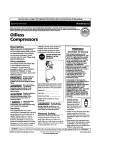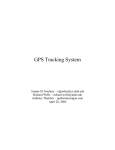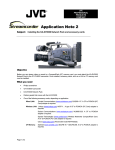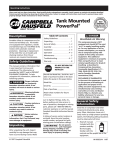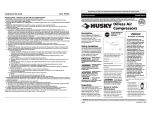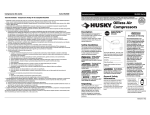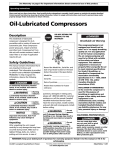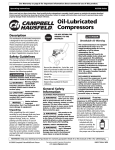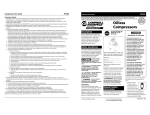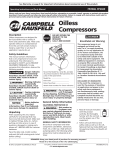Download Campbell Hausfeld Air Compressor Operating instructions
Transcript
WL6000 Series IT SSURANCE PR YA RAM OG Please read and save these instructions. Read carefully before attempting to assemble, install, operate or maintain the product described. Protect yourself and others by observing all safety information. Failure to comply with instructions could result in personal injury and/or property damage! Retain instructions for future reference. Need Assistance? Call Us First! QUAL Operating Instructions 1-800-543-8622 TM BUILT TO LAST Description Oilless compressors are designed for do-it-yourselfers with a variety of home and automotive jobs. These compressors will power spray guns, impact wrenches and other tools. These units operate without oil. Oilless Compressors A listing of service center locations is enclosed. Have the serial number, model number and parts list (with missing parts circled before calling). STOP! DO NOT RETURN THE PRODUCT TO THE RETAILER! Safety Guidelines This manual contains information that is very important to know and understand. This information is provided for SAFETY and to PREVENT EQUIPMENT PROBLEMS. To help recognize this information, observe the following symbols. Danger indicates an imminently hazardous situation which, if not avoided, will result in death or serious injury. Warning indicates a potentially hazardous situation which, if not avoided, could result in death or serious injury. Caution indicates a potentially hazardous situation which, if not avoided, may result in minor or moderate injury. Notice indicates important information, that if not followed, may cause damage to equipment. ! NOTICE Unpacking After unpacking the unit, inspect carefully for any damage that may have occurred during transit. Make sure to tighten fittings, bolts, etc., before putting unit into service. In case of questions, damaged or missing parts, please call 1-800-543-6400 for customer assistance or call the nearest Campbell Hausfeld Authorized Service Center. © 1997 Campbell Hausfeld Record the Model No., Serial No. and date of purchase located on the base below the pump in the space below. Model No. ____________________ Serial No. ____________________ Date of purchase _________________ Retain these numbers for future reference. Do not operate unit if damaged during shipping, handling or use. Damage may result in bursting and cause injury or property damage. General Safety Since the air compressor and other components (material pump, spray guns, filters, lubricators, hoses, etc.) used, make up a high pressure pumping system, the following safety precautions must be observed at all times: Breathable Air Warning This compressor/pump is NOT equipped and should NOT be used “as is” to supply breathing quality air. For any application of air for human consumption, you must fit the air compressor/pump with suitable in-line safety and alarm equipment. This additional equipment is necessary to properly filter and purify the air to meet minimal specifications for Grade D breathing as described in Compressed Gas Association Commodity Specification G 7.1 1966, OSHA 29 CFR 1910. 134, and/or Canadian Standards Associations (CSA). DISCLAIMER OF WARRANTIES IN THE EVENT THE COMPRESSOR IS USED FOR THE PURPOSE OF BREATHING AIR APPLICATION AND PROPER IN-LINE SAFETY AND ALARM EQUIPMENT IS NOT SIMULTANEOUSLY USED, EXISTING WARRANTIES ARE VOID, AND CAMPBELL HAUSFELD DISCLAIMS ANY LIABILITY WHATSOEVER FOR ANY LOSS, PERSONAL INJURY OR DAMAGE. 1. Read all manuals included with this product carefully. Be MANUAL thoroughly familiar with the controls and the proper use of the equipment. 2. Follow all local electrical and safety codes, as well as in the U.S., National Electrical Codes (NEC) and Occupational Safety and Health Act (OSHA). 3. Only persons well acquainted with these rules of safe operation should be allowed to use the compressor. IN221701AV 11/97 Operating Instructions General Safety (Con’t) 4. Keep visitors away and NEVER allow children in the work area. 5. Wear safety glasses and use hearing protection when operating the pump or unit. 6. Do not stand on or use the pump or unit as a handhold. 7. Before each use, inspect compressed air system and electrical components for signs of damage, deterioration, weakness or leakage. Repair or replace defective items before using. 8. Check all fasteners at frequent intervals for proper tightness. Motors, electrical equipment and controls can cause electrical arcs that will ignite a flammable gas or vapor. Never operate or repair in or near a flammable gas or vapor. Never store flammable liquids or gases in the vicinity of the compressor. Compressor parts may be hot even if the unit is stopped. 9. Keep fingers away from a running compressor; fast moving and hot parts will cause injury and/or burns. 10. If the equipment should start to abnormally vibrate, STOP the engine/motor and check immediately for the cause. Vibration is generally a warning of trouble. 11. To reduce fire hazard, keep engine/motor exterior free of oil, solvent, or excessive grease. Never remove or attempt to adjust safety valve. Keep safety valve free from paint and other accumulations. Never attempt to repair or modify a tank! Welding, drilling or any other modification will weaken the tank resulting in damage from rupture Oilless Compressors or explosion. Always replace worn or damaged tanks. ! NOTICE Drain liquid from tank daily. 12. Tanks rust from moisture build-up, which weakens the tank. Make sure to drain tank regularly and inspect periodically for unsafe conditions such as rust formation and corrosion. 13. Fast moving air will stir up dust and debris which may be harmful. Release air slowly when draining moisture or depressurizing the compressor system. SPRAYING PRECAUTIONS Do not spray flammable materials in vicinity of open flame or near ignition sources including the compressor unit. 14. Do not smoke when spraying paint, insecticides, or other flammable substances. 15. Use a face mask/ respirator when spraying and spray in a well ventilated area to prevent health and fire hazards. 16. Do not direct paint or other sprayed material at the compressor. Locate compressor as far away from the spraying area as possible to minimize overspray accumulation on the compressor. 17. When spraying or cleaning with solvents or toxic chemicals, follow the instructions provided by the chemical manufacturer. Do not locate the compressor air inlet near steam, paint spray, sandblast areas or any other source of contamination. This debris will damage the motor. ELECTRICAL INSTALLATION All wiring and electrical connections should be performed by a qualified electrician. Installation must be in accordance with local codes and national electrical codes. Never use an extension STOP! cord with this product. Use additional air hose instead of an extension cord to avoid power loss and permanent motor damage. Use of an extension cord voids the warranty. GROUNDING INSTRUCTIONS 1. This product is for use on a nominal 120 volt circuit and has a grounding plug that looks like the plug illustrated in Figure 1. Make sure the product is connected to an outlet having the same configuration as the plug. This product must be grounded. In the event of an electrical short circuit, grounding reduces risk of electrical shock by providing an escape wire for electric current. This product is equipped with a cord having a grounding wire with an appropriate grounding plug. Plug must be plugged into an outlet that is properly installed and grounded in accordance with all local codes and ordinances. Grounded Pin TEST RESET Installation LOCATION It is extremely important to install the compressor in a clean, well ventilated area where the surrounding air temperature will not be more than 100°F. A minimum clearance of 4 inches between the compressor and a wall is required because objects could obstruct air flow. 2 Figure 1 Grounded Outlet Improper use of grounding plug can result in a possible risk of electrical shock! Do not use a grounding adapter with this product! Operating Instructions WL6000 Series Installation (Con’t) 2. If repair or replacement of cord or plug is necessary, do not connect grounding wire to either flat blade terminal. The wire with insulation having an external surface that is green (with or without yellow stripes) is the grounding wire. Never connect green (or green and yellow) wire to a live terminal. 3. Check with a qualified electrician or serviceman if grounding instructions are not completely understood, or if in doubt as to whether product is properly grounded. Do not modify plug provided; if it will not fit outlet, have proper outlet installed by a qualified electrician. WIRING 1. Local electrical wiring codes differ from area to area. Source wiring, plug and protector must be rated for at least the amperage and voltage indicated on motor nameplate, and meet all electrical codes for this minimum. 2. Use a slow blow fuse or a circuit breaker. Overheating, short circuiting and fire damage will result from inadequate wiring, etc. Discharge Tube (Opposite Side) NOTE: 120 volt, 15 amp units can be operated on a 120 volt circuit under the following conditions: a. No other electrical appliances or lights are connected to the same branch circuit. b. Voltage supply is normal. c. Circuit is equipped with a 15 amp circuit breaker or a 15 amp slow blow fuse. 3. If these conditions cannot be met or if nuisance tripping of current protection device occurs, it may be necessary to operate compressor from a 120 volt, 20 amp circuit. Operation Pressure switch - Auto/Off Switch - In the AUTO position, the compressor shuts off automatically when tank pressure reaches the maximum preset pressure. In the OFF position, the compressor will not operate. This switch should be in the OFF position when connecting or disconnecting the power cord from the electrical outlet or when changing air tools. Regulator - The regulator controls the amount of air pressure released at the hose outlet. ASME Safety Valve - This valve automatically releases air if the tank pressure exceeds the preset maximum. Check Valve (Opposite Side) Tank Pressure Gauge Regulator Pressure Switch Air Hose Attachment Safety Valve Outlet Pressure Gauge MOISTURE IN COMPRESSED AIR Moisture in compressed air will form into droplets as it comes from an air compressor pump. When humidity is high or when a compressor is in continuous use for an extended period of time, this moisture will collect in the tank. When using a paint spray or sandblast gun, this water will be carried from the tank through the hose, and out of the gun as droplets mixed with the spray material. IMPORTANT: This condensation will cause water spots in a paint job, especially when spraying other than water based paints. If sandblasting, it will cause the sand to cake and clog the gun, rendering it ineffective. A filter in the air line (MP3105), located as near to the gun as possible, will help eliminate this moisture. Discharge tube - This tube carries compressed air from the pump to the check valve. This tube becomes very hot during use. To avoid the risk of severe burns, never touch the discharge tube. Check valve - One-way valve that allows air to enter the tank, but prevents air in the tank from flowing back into the compressor pump. Drain Petcock - This valve is located on the bottom of the tank. Use this valve to drain moisture from the tank daily to reduce the risk of corrosion. Reduce tank pressure below 10 PSI, then drain moisture from tank daily to avoid tank corrosion. Drain moisture from tank(s) by opening the drain petcock located underneath the tank. LUBRICATION This is an oilless product and does not require lubrication to operate. BREAK-IN PROCEDURE Do not attach air chuck or other tool to open end of hose until start-up has been completed and unit checks OK. IMPORTANT: Do not operate compressor before reading instructions or damage may result. Drain Petcock 1. Turn regulator fully clockwise to open air flow. Figure 2 3 Oilless Compressors Operating Instructions Operation (Con’t.) 2. Turn switch to OFF position and plug in power cord. 3. Turn switch to AUTO position and run unit for 30 minutes to break in the pump parts. Off Auto Figure 3 4. Turn regulator knob fully counterclockwise. Compressor will build to maximum preset pressure and shut off. 5. Turn regulator knob clockwise to cause air to bleed off. Compressor will restart at a preset pressure. 6. Turn regulator knob counterclockwise to shut off the air and turn switch to Off position. 7. Attach chuck or other tool to open end of hose. Turn the regulator on. In the AUTO position, the compressor pumps air into the tank. It shuts off automatically when unit reaches its maximum preset pressure. In the OFF position, the pressure switch cannot function and the compressor will not operate. This switch should be in the OFF position when connecting or disconnecting the power cord from the electrical outlet. ASME SAFETY VALVE Do not remove or attempt to adjust the safety valve! This valve should be checked under pressure occasionally by pulling the ring by hand. If air leaks after Figure 4 ring has been released, or valve is stuck and cannot be actuated by ring, it MUST be replaced. REGULATOR KNOB 1. This knob controls air pressure to an air operated tool, or paint spray gun. 2. Turning knob clockwise increases air pressure at outlet. 3. Turning counterclockwise will lower air pressure at outlet. 4. Fully counterclockwise will shut off flow of air completely. OUTLET PRESSURE GAUGE 1. This gauge shows at-a-glance, air pressure at outlet. Air pressure is measured in pounds per square inch (PSI). 2. Be sure this gauge reads ZERO before changing air tools or disconnecting hose from outlet. TANK PRESSURE GAUGE Gauge shows pressure in tank indicating compressor is building pressure properly. Maintenance allow to prevent over-spray from clogging filter. AIR FILTER Check air filter to be sure it is clean. To service a filter, remove the filter housing cover. Remove filter and clean in hot, soapy water (Paper filters cannot be washed). Rinse and let dry. Replace air filters that cannot be cleaned. Place filter back in the housing base. Replace cover. LUBRICATION This is an oilless type compressor requiring no lubrication. THERMAL OVERLOAD PROTECTOR This compressor is equipped with an automatic reset thermal overload protector which will shut off motor if it becomes overheated. If thermal overload protector shuts motor OFF frequently look for the following causes Disconnect power source then release all pressure from the system before attempting to install, service, relocate or perform any maintenance. The compressor should be checked often for any visible problems and the following maintenance procedures should be performed each time the compressor is used. 1. Pull ring on safety valve and allow it to snap back to normal position. Safety valve must be replaced if it cannot be actuated or it leaks air after ring is released. 2. With compressor shut off and pressure released: Drain moisture from tank by opening drain cock underneath tank (See Figure 5). 1. Low voltage 2. Clogged air filter 3. Lack of proper ventilation If the thermal overload protector is actuated, the motor must be allowed to cool down before start-up is pos- sible. The motor will automatically restart without warning if left plugged into electrical outlet and unit is turned on. TORQUE REQUIREMENTS Connecting rod bolt . . . . . . . . 20 in. Ibs. Compressor hd. bolts. . . 100-110 in. Ibs. Motor bolts . . . . . . . . . . . . . . . 35 in. Ibs. Mounting bolts . . . . . . . . . . . . 90 in. Ibs. STORAGE 1. When not in use, store hose and compressor in a cool, dry place. 2. Drain tank of moisture 3. Disconnect hose and hang open ends down to allow any moisture to drain. Figure 5 3. Turn power OFF and clean dust and dirt from motor, tank, air lines and pump cooling fins. IMPORTANT: Unit should be located as far from spraying area as hose will 4 Operating Instructions WL6000 Series Troubleshooting Chart Symptom Possible Cause(s) Corrective Action Compressor will not run 1. 2. 3. 4. 5. 6. 1. 2. 3. 4. 5. 6. Motor hums but cannot run or runs slowly 1. Poor contacts, line voltage incorrect 2. Shorted or open motor winding 3. Defective check valve or unloader 1. Check connections, check with voltmeter 2. Replace motor 3. Replace or repair Do not disassemble check valve with air in tank; bleed tank Fuses blow/circuit breaker trips repeatedly 1. Incorrect size fuse, circuit overloaded 1. Check for proper fuse, use time-delay fuse. Disconnect other electrical appliances from circuit or operate compressor on its own branch circuit. 2. Replace or repair Do not disassemble check valve with air in tank; bleed tank No electrical power Blown fuse Breaker open Thermal overload open Pressure switch bad Check valve defective 2. Defective check valve or unloader Never use an extension cord with this product Thermal overload protector cuts out repeatedly 1. Low voltage 2. Clogged air filter 3. Lack of proper ventilation/room temperature too high 4. Check valve malfunction Plugged in? Check fuse/breaker or motor overload. Replace blown fuse Reset, determine cause of problem Motor will restart when cool Replace Remove and replace check valve Do not disassemble check valve with air in tank; bleed tank 1. Check with voltmeter 2. Clean filter (see Maintenance section) 3. Move compressor to well ventilated area 4. Replace Do not disassemble check valve with air in tank; bleed tank Knocks, rattles, excessive vibration 1. Leaking, broken, or loose valves or restricted air passage 2. Defective pressure switch unloader 3. Defective bearing on eccentric or motor shaft 4. Cylinder or piston ring is worn or scored 5. Loose bolts, tank not level 1. Replace Tank pressure drops when compressor shuts off 1. Loose connections (fittings, tubing, etc.) 2. Loose drain cock 3. Check valve leaking 1. Check all connections with soap and water solution and tighten 2. Tighten 3. Disassemble check valve assembly, clean or replace Do not disassemble check valve with air in tank; bleed tank Air output lower than normal/low discharge pressure 1. Clogged intake filter 2. Air leaks in piping (on machine or in outside system) 3. Broken inlet valves 4. Piston ring broken 5. Cylinder or piston ring is worn or scored 1. Clean or replace 2. Replace leaking components or tighten as necessary Excessive moisture in discharge air 1. Excessive water in tank 2. High humidity 1. Drain tank 2. Move to area of less humidity; use air line filter Compressor runs continuously 1. Defective pressure switch 2. Excessive air usage 1. Replace switch 2. Decrease air usage; compressor not large enough for air requirement Excessive starting and stopping (auto start) 1. Excessive condensation in tank 2. Air leaks in piping (on machine or in outside system) 3. Tank check valve leaking 1. Drain more often 2. Replace leaking components or tighten as necessary Check valve stuck in an open position Remove and replace check valve Do not disassemble check valve with air in tank; bleed tank Air leaking from unloader on pressure switch 5 2. 3. 4. 5. Replace or repair as necessary Replace Replace or repair as necessary Tighten bolts, shim tank to level position 3. Have authorized service representative repair unit 4. Replace 5. Replace 3. Replace or repair as necessary Do not disassemble check valve with air in tank; bleed tank Operating Instructions Oilless Compressors Limited Warranty 1. DURATION: From the date of purchase by the original purchaser as follows: Standard Duty Products - One Year, Serious Duty Products - Two Years, Extreme Duty Products - Three Years. 2. WHO GIVES THIS WARRANTY (WARRANTOR): Campbell Hausfeld / Scott Fetzer Company, 100 Production Drive, Harrison, Ohio, 45030, Telephone: (513) 367-4811 3. WHO RECEIVES THIS WARRANTY (PURCHASER): The original purchaser (other than for purposes of resale) of the Campbell Hausfeld product. 4. WHAT PRODUCTS ARE COVERED BY THIS WARRANTY: Any Campbell Hausfeld air compressor, air tool or supplementary air accessory supplied or manufactured by Warrantor. 5. WHAT IS COVERED UNDER THIS WARRANTY: Defects due to material and workmanship with the exceptions noted below. 6. WHAT IS NOT COVERED UNDER THIS WARRANTY: A. Implied warranties, including those of merchantability and FITNESS FOR A PARTICULAR PURPOSE ARE LIMITED FROM THE DATE OF ORIGINAL PURCHASE AS STATED IN THE DURATION. If this product is used for commercial, industrial or rental purposes, the warranty will apply for ninety (90) days from the date of purchase. Four cylinder single-stage and two-stage products are not limited to a ninety (90) day warranty when used in commercial or industrial applications. Some States do not allow limitations on how long an implied warranty lasts, so the above limitations may not apply to you. B. ANY INCIDENTAL, INDIRECT, OR CONSEQUENTIAL LOSS, DAMAGE, OR EXPENSE THAT MAY RESULT FROM ANY DEFECT, FAILURE, OR MALFUNCTION OF THE CAMPBELL HAUSFELD PRODUCT. Some States do not allow the exclusion or limitations of incidental or consequential damages, so the above limitation or exclusion may not apply to you. C. Any failure that results from an accident, purchaser’s abuse, neglect or failure to operate products in accordance with instructions provided in the owner’s manual(s) supplied with product. D. Pre-delivery service, i.e. assembly, oil or lubricants, and adjustment. E. Normal adjustments or expendable items which are explained in the owner’s manual(s) provided with the product including but not limited to belts and pressure switch. F. Items or service that are normally required to maintain the product, i.e. lubricants, filters and gaskets, etc. G. Gasoline engines and components are expressly excluded from coverage under this limited warranty. The Purchaser must comply with the warranty given by the engine manufacturer which is supplied with the product. H. Additional items not covered under this warranty: 1. All Compressors Maintenance records must be provided to make warranty claim a. Any component damaged in shipment or any failure caused by installing or operating unit under conditions not in accordance with installation and operation guidelines. b. Pump or valve failure caused by rain, excessive humidity or corrosive environments. c. Cosmetic defects that do not interfere with compressor functionality. d. Rusted tanks, including but not limited to rust due to improper drainage. e. Check valves after the first year of ownership. f. Drain cocks. g. Motor capacitors. h. Damage due to improper wiring. 2. Lubricated Compressors a. Pump wear or valve damage caused by using oil not specified. b. Pump wear or valve damage caused by any oil contamination or by failure to follow proper oil maintenance guidelines. 3. Belt Drive / Direct Drive / Gas Driven Compressors a. Belts. b. Ring wear from inadequate filter maintenance. c. Manually adjusted load/unload and throttle control devices. 7. RESPONSIBILITIES OF WARRANTOR UNDER THIS WARRANTY: Repair or replace, at Warrantor’s option, products or components which are defective, have malfunctioned and/or failed to conform within duration of the warranty period. 8. RESPONSIBILITIES OF PURCHASER UNDER THIS WARRANTY: A. Deliver or ship the Campbell Hausfeld product or component to the nearest Campbell Hausfeld Authorized Service Center. Freight costs, if any, must be borne by the purchaser. B. Use reasonable care in the operation and maintenance of the products as described in the owner’s manual(s). 9. WHEN WARRANTOR WILL PERFORM REPAIR OR REPLACEMENT UNDER THIS WARRANTY: A. Repair or replacement will be scheduled and serviced according to the normal work flow at the servicing location, and depending on the availability of replacement parts. B. If the purchaser does not receive satisfactory results from the Authorized Service Center, the purchaser should contact the Campbell Hausfeld Product Service Department (see paragraph 2). This Limited Warranty gives you specific legal rights and you may also have other rights which vary from State to State. 6






